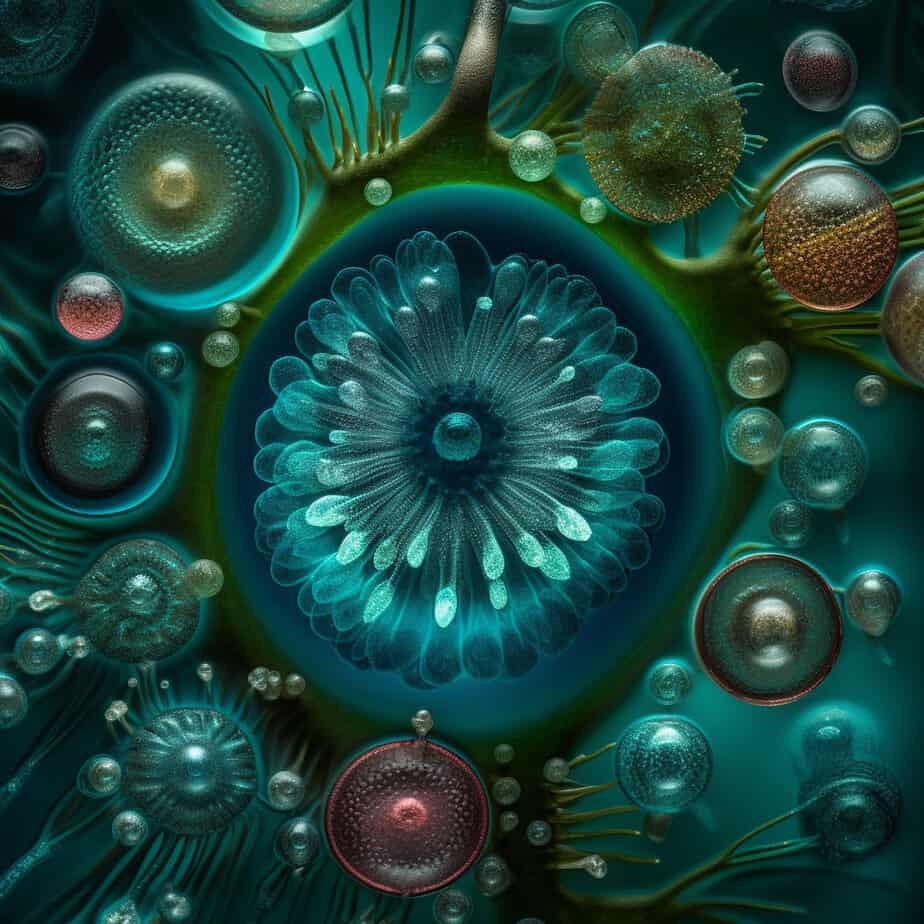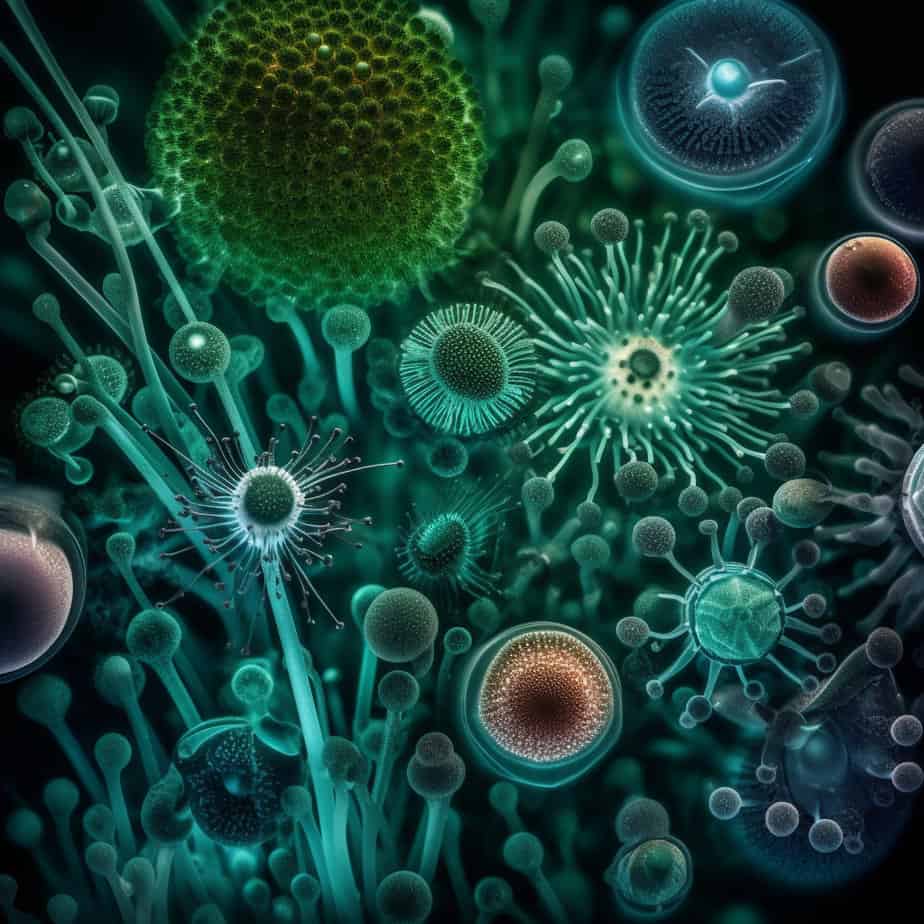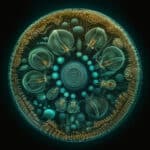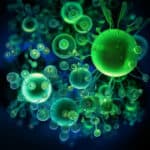Phytoplankton are microscopic organisms that play a crucial role in marine ecosystems. These tiny plants are responsible for producing a significant portion of the Earth’s oxygen and form the base of the marine food chain. While many people may be familiar with the concept of shells in larger marine organisms like clams or snails, the question arises: do phytoplankton have shells? The answer is yes and no. Some species of phytoplankton possess shells, known as frustules, while others do not. These frustules are made of silica or calcium carbonate and provide structural support to the organisms. In this article, we will explore the different types of phytoplankton and their shell structures, as well as the importance of these shells in their survival and ecological significance. So, let’s dive in and discover the fascinating world of phytoplankton and their shells.
Key Takeaways
- Phytoplankton are microscopic organisms that play a crucial role in marine ecosystems.
- While some phytoplankton species have shells made of silica or calcium carbonate, not all phytoplankton have shells.
- The presence or absence of shells in phytoplankton can impact their ecological functions and susceptibility to environmental changes.
- Understanding the diversity and characteristics of phytoplankton shells is important for studying marine ecosystems and their response to climate change.
Understanding Phytoplankton: A Brief Overview
A. Definition and Characteristics of Phytoplankton
Phytoplankton are microscopic algae that play a crucial role in aquatic ecosystems. These photosynthetic plankton are responsible for producing about half of the world’s oxygen, making them vital for sustaining life on Earth. Unlike other types of plankton, such as zooplankton, phytoplankton are capable of harnessing energy from the sun through photosynthesis.
Phytoplankton come in various shapes and sizes, ranging from single-celled organisms to complex colonies. They can be found in both freshwater and marine environments, thriving in oceans, lakes, rivers, and even puddles. These tiny organisms are incredibly diverse, with thousands of different species identified so far.
B. The Habitat of Phytoplankton: Where Can You Find Them?
Phytoplankton are found throughout the world’s oceans, from the surface waters to the deep sea. They are particularly abundant in areas where nutrient-rich waters are present, such as upwelling zones where cold, nutrient-rich water rises from the depths. These areas often experience high levels of primary productivity, making them hotspots for marine life.
In addition to open ocean habitats, phytoplankton can also be found in coastal areas, estuaries, and even in freshwater bodies like lakes and ponds. They are highly adaptable and can thrive in a wide range of environmental conditions, including varying temperatures, salinity levels, and light availability.
The distribution of phytoplankton is influenced by several factors, including water temperature, nutrient availability, and the presence of predators. Some species of phytoplankton are more common in colder waters, while others prefer warmer tropical regions. These microorganisms are an essential part of the oceanic food chain, serving as a primary food source for many marine organisms, including zooplankton, small fish, and even whales.
Understanding the habitat preferences and distribution patterns of phytoplankton is crucial for studying their role in the global carbon cycle and the overall health of marine ecosystems. Changes in phytoplankton populations can have significant implications for climate change and the functioning of the oceanic food web.
In the next section, we will explore the fascinating structures and adaptations of phytoplankton, shedding light on their unique characteristics and the role they play in the marine environment.
The Intricacies of Phytoplankton Shells
A. Do Phytoplankton Have Shells?
Phytoplankton, the microscopic algae that inhabit the world’s oceans, play a vital role in sustaining aquatic ecosystems. These photosynthetic plankton are responsible for producing a significant portion of the Earth’s oxygen and form the foundation of the oceanic food chain. But do phytoplankton have shells?
The answer to this question is not a straightforward one. While not all phytoplankton species possess shells, a significant group of them, known as diatoms, do indeed have shells. Diatoms are a type of phytoplankton that are encased in intricate and beautiful silica shells, also known as frustules. These shells are incredibly diverse in shape and size, ranging from simple cylindrical structures to intricate and ornate designs.
B. The Role and Composition of Phytoplankton Shells
The shells of diatoms serve several important functions. Firstly, they provide protection for the delicate phytoplankton cells, shielding them from environmental stressors such as predation and turbulent water currents. Additionally, these shells play a crucial role in the buoyancy of diatoms, allowing them to float in the water column and access sunlight for photosynthesis.
The composition of diatom shells is primarily made up of silica, a compound commonly found in sand and glass. Silica provides strength and rigidity to the shells, allowing them to withstand the pressures of the oceanic environment. Interestingly, diatom shells are so durable that they can accumulate over time and form deposits known as diatomaceous earth, which has various industrial applications.
The intricate designs of diatom shells are not only visually stunning but also serve a functional purpose. The unique patterns and structures of these shells increase the surface area available for nutrient absorption, enabling diatoms to efficiently gather essential elements like nitrogen, phosphorus, and silica from their surroundings. This ability to capture and utilize nutrients is crucial for the growth and reproduction of diatoms, contributing to their ecological success.
Understanding the role and composition of phytoplankton shells is not only fascinating from a scientific perspective but also has broader implications for our understanding of marine biology and the Earth’s ecosystems. Phytoplankton, including diatoms, play a vital role in the global carbon cycle, absorbing carbon dioxide through photosynthesis and acting as a significant sink for atmospheric carbon. Changes in phytoplankton populations and their shell formation can have far-reaching consequences for climate change and the health of our oceans.
In conclusion, while not all phytoplankton species have shells, diatoms, a prominent group of phytoplankton, possess intricate silica shells that serve multiple functions. These shells provide protection, buoyancy, and nutrient absorption capabilities, contributing to the ecological success of diatoms. Understanding the intricacies of phytoplankton shells is crucial for comprehending the role of these microscopic organisms in marine ecosystems and their impact on the global carbon cycle.
The Importance of Phytoplankton in the Ecosystem
A. Why Do We Need Phytoplankton?
Phytoplankton, the microscopic algae that inhabit the world’s oceans, play a crucial role in maintaining the health and balance of aquatic ecosystems. These photosynthetic plankton are responsible for producing a significant portion of the Earth’s oxygen, making them essential for the survival of all life forms, including humans.
One of the primary reasons why we need phytoplankton is their ability to perform photosynthesis. Through this process, they convert carbon dioxide and sunlight into organic compounds, releasing oxygen as a byproduct. In fact, it is estimated that phytoplankton contribute to about 50% of the oxygen in the Earth’s atmosphere. Without them, the air we breathe would be significantly depleted of oxygen, making it difficult for us and other organisms to survive.
Phytoplankton also play a crucial role in the carbon cycle. As they photosynthesize, they absorb carbon dioxide from the atmosphere, effectively acting as a natural carbon sink. This process helps regulate the levels of greenhouse gases in the atmosphere, mitigating the impacts of climate change. Additionally, when phytoplankton die, they sink to the ocean floor, taking carbon with them and sequestering it for long periods of time.
B. Phytoplankton’s Role in the Food Chain: Are They Omnivores?
Phytoplankton are not omnivores, but rather the primary producers in the oceanic food chain. They form the base of the marine food web, providing sustenance for a wide range of organisms, from tiny zooplankton to large marine mammals.
These microscopic algae are consumed by zooplankton, which in turn are eaten by larger organisms such as fish, whales, and even humans. This transfer of energy from phytoplankton to higher trophic levels is essential for the functioning of marine ecosystems.
The abundance and diversity of phytoplankton species are crucial for maintaining a healthy food web. Different species of phytoplankton have varying nutritional profiles, providing a variety of essential nutrients to the organisms that consume them. This diversity ensures that the entire ecosystem is well-nourished and able to support a wide range of marine life.
In conclusion, phytoplankton are not only vital for the production of oxygen and the regulation of the Earth’s climate, but they also form the foundation of the oceanic food chain. Their role as primary producers sustains the entire marine ecosystem, making them indispensable for the well-being of our planet. Understanding and protecting these microscopic organisms is crucial for maintaining the delicate balance of our oceans and ensuring the survival of countless species, including our own.
The Diet of Phytoplankton: What Do They Consume?

A. What Do Phytoplankton Eat?
Phytoplankton, as microscopic algae, play a crucial role in aquatic ecosystems. These photosynthetic plankton are responsible for producing a significant portion of the Earth’s oxygen, making them vital to the health of our planet. But what exactly do these tiny organisms consume?
Phytoplankton obtain their nutrients through a process called photosynthesis. Like plants on land, they use sunlight, carbon dioxide, and nutrients to create energy-rich organic compounds. The primary nutrients required by phytoplankton include nitrogen, phosphorus, and trace elements such as iron and zinc.
In the ocean, phytoplankton can obtain these nutrients from various sources. Some species can directly absorb dissolved nutrients from the water, while others rely on recycling processes within the marine food web. For example, when larger organisms like zooplankton consume phytoplankton, they release waste material that contains nutrients. These nutrients can then be recycled and used by other phytoplankton.
B. The Impact of Phytoplankton’s Diet on Their Shell Formation
While not all phytoplankton species have shells, certain types, such as diatoms, do possess intricate silica shells. The composition and formation of these shells are influenced by the diet of the phytoplankton.
Diatoms, a common type of phytoplankton, have a unique ability to extract silica from their environment and incorporate it into their shells. Silica is a naturally occurring compound found in rocks, sand, and even the skeletons of marine organisms. Diatoms use this silica to construct their intricate shells, which can have elaborate patterns and structures.
The availability of silica in the water directly impacts the growth and development of diatoms. When silica concentrations are high, diatoms can produce larger and more complex shells. Conversely, when silica is limited, diatoms may produce smaller or simpler shells.
The diet of diatoms also influences their shell composition. Diatoms require a steady supply of nutrients, including silica, to build and maintain their shells. When diatoms have access to an abundance of nutrients, they can produce thicker shells. Conversely, nutrient limitations can result in thinner shells.
Understanding the relationship between phytoplankton’s diet and their shell formation is crucial for studying the impact of climate change on marine ecosystems. Changes in nutrient availability, such as increased nutrient runoff from land or alterations in oceanic circulation patterns, can have significant consequences for phytoplankton populations and their ability to form shells.
In conclusion, while not all phytoplankton have shells, certain species like diatoms possess intricate silica shells. The diet of phytoplankton, particularly diatoms, plays a crucial role in their shell formation. Nutrient availability, including silica, directly influences the size, complexity, and composition of these shells. By studying the relationship between phytoplankton’s diet and their shell formation, scientists can gain valuable insights into the impact of environmental changes on marine ecosystems.
The World of Plankton: A Comparative Analysis

A. Do Plankton Have Shells?
When we think of the vastness of the oceans, it’s easy to overlook the microscopic organisms that play a crucial role in marine ecosystems. Plankton, a diverse group of organisms, are at the heart of this intricate web of life. But do all plankton have shells? Let’s explore the fascinating world of phytoplankton and their unique structures.
Phytoplankton, a type of plankton, are microscopic algae that perform photosynthesis in the oceans. They are responsible for producing a significant portion of the Earth’s oxygen and form the base of the marine food chain. While some phytoplankton species do have shells, not all of them possess this characteristic.
Phytoplankton Structure
The structure of phytoplankton can vary greatly depending on the species. One common type of phytoplankton with shells is diatoms. Diatoms are single-celled algae that have a distinctive silica shell, known as a frustule. These intricate shells are made up of two overlapping halves, giving them a unique appearance under a microscope.
The composition of diatom shells is primarily silica, which is a type of glass. This silica shell provides diatoms with protection and buoyancy, allowing them to float near the ocean‘s surface where sunlight is abundant for photosynthesis. The intricate patterns and designs on diatom shells are not only visually stunning but also serve as a means of identification for different species.
Phytoplankton and the Carbon Cycle
The presence of phytoplankton, including those with shells like diatoms, is crucial for the Earth’s carbon cycle. Through photosynthesis, phytoplankton absorb carbon dioxide from the atmosphere and convert it into organic matter. This process helps regulate the Earth’s climate by reducing the amount of greenhouse gases in the air.
When phytoplankton die, their shells sink to the ocean floor, where they become part of a sediment known as diatomaceous earth. Over time, this sediment can accumulate and form thick layers. Diatomaceous earth has various industrial uses, including filtration, insulation, and even as an ingredient in toothpaste.
B. Distinguishing Phytoplankton from Other Plankton Species
While phytoplankton are a type of plankton, it’s important to understand how they differ from other planktonic organisms. Phytoplankton are photosynthetic, meaning they can produce their own food using sunlight. This sets them apart from zooplankton, which are non-photosynthetic and rely on consuming other organisms for nutrition.
Phytoplankton species can vary in size, shape, and color. Some are unicellular, while others form colonies. They can range from being spherical to elongated or even ribbon-like in shape. Additionally, phytoplankton come in a wide array of colors, including green, brown, and red, depending on the pigments they contain.
Zooplankton, on the other hand, encompass a diverse group of organisms, including tiny animals such as copepods, krill, and jellyfish larvae. Unlike phytoplankton, zooplankton do not possess shells. Instead, they have various adaptations that allow them to float and move through the water column.
Understanding the differences between phytoplankton and other planktonic species is essential for studying and monitoring aquatic ecosystems. By examining the composition and abundance of different plankton groups, scientists can gain insights into the health and dynamics of marine environments.
In conclusion, while not all plankton have shells, some phytoplankton species, such as diatoms, do possess intricate silica shells. These structures provide protection and buoyancy, allowing phytoplankton to thrive near the ocean‘s surface. By performing photosynthesis, phytoplankton play a vital role in the carbon cycle, regulating the Earth’s climate. Distinguishing phytoplankton from other planktonic organisms is crucial for understanding the complexities of marine ecosystems and their delicate balance.
The Art of Collecting Phytoplankton

A. How to Collect Phytoplankton Safely and Effectively
Collecting phytoplankton can be an exciting and rewarding endeavor. Not only does it provide valuable insights into the health of aquatic ecosystems, but it also helps scientists understand the intricate workings of our oceans. If you’re interested in embarking on your own phytoplankton collection journey, here are some tips to help you get started.
-
Choose the Right Equipment: To collect phytoplankton, you’ll need a few essential tools. A plankton net, also known as a phytoplankton net, is a fine mesh net that allows you to filter out the tiny organisms from the water. Additionally, you’ll need sample containers, such as glass jars or plastic bottles, to store the collected samples.
-
Select the Sampling Location: Phytoplankton can be found in various aquatic environments, including freshwater lakes, rivers, and marine ecosystems. Choose a sampling location that aligns with your research goals. For example, if you’re interested in studying marine phytoplankton, head to the coast or offshore areas.
-
Sampling Technique: When collecting phytoplankton, it’s important to follow proper sampling techniques to ensure accurate results. Lower the plankton net into the water, making sure it’s fully submerged. Slowly tow the net through the water, allowing it to capture the phytoplankton. The duration of the tow will depend on the volume of water you wish to sample.
-
Handle with Care: Phytoplankton are delicate organisms, so it’s crucial to handle them with care. Avoid excessive shaking or agitation, as this can damage the cells and affect the accuracy of your samples. Once you’ve collected the samples, transfer them to the sample containers, taking care not to introduce any contaminants.
-
Preservation and Storage: To preserve the phytoplankton samples, you can use various methods, such as fixing the cells with formaldehyde or freezing them. Different preservation techniques are suitable for different research purposes, so it’s essential to consult scientific literature or seek guidance from experts in the field.
B. Precautions and Tips for Phytoplankton Collection
While collecting phytoplankton can be a fascinating experience, it’s important to take certain precautions to ensure your safety and the well-being of the environment. Here are some tips to keep in mind:
-
Be Mindful of Local Regulations: Before collecting phytoplankton, familiarize yourself with any local regulations or permits required for sampling. Some areas may have restrictions or guidelines in place to protect sensitive ecosystems, so it’s crucial to abide by these rules.
-
Avoid Contamination: To obtain accurate results, it’s essential to prevent contamination of your samples. Rinse all equipment thoroughly before use to remove any potential contaminants. Additionally, avoid touching the inside of the sample containers or the net mesh with your hands to minimize the introduction of foreign substances.
-
Consider Weather Conditions: Weather conditions can significantly impact phytoplankton distribution and abundance. When planning your collection trips, take into account factors such as wind, tides, and water temperature. These variables can influence the composition of the phytoplankton community and affect the reliability of your data.
-
Document Your Findings: Keeping detailed records of your sampling efforts is crucial for scientific research. Note the date, time, and location of each collection, as well as any relevant environmental parameters, such as water temperature and salinity. This information will help contextualize your findings and contribute to a more comprehensive understanding of phytoplankton dynamics.
By following these guidelines, you can embark on a successful phytoplankton collection journey. Remember, phytoplankton play a vital role in marine ecosystems and the global carbon cycle, so your contributions to the field of marine biology are invaluable. Happy collecting! Conclusion
In conclusion, phytoplankton are a diverse group of microscopic organisms that play a crucial role in the Earth’s ecosystems. While many species of phytoplankton do not have shells, there are certain types that possess intricate and beautiful structures made of silica or calcium carbonate. These shells, known as frustules, provide protection and support to the phytoplankton, allowing them to thrive in various aquatic environments. The presence of shells also enables scientists to study and identify different species of phytoplankton under the microscope. Understanding the presence and composition of these shells is essential for comprehending the ecological dynamics of marine and freshwater ecosystems. As we continue to explore and learn more about phytoplankton, their shells will undoubtedly remain an area of fascination and importance in the field of marine biology.
Frequently Asked Questions
Where can you find phytoplankton?
Phytoplankton, which are microscopic algae, are found in both fresh and saltwater environments. They are most commonly found in the upper sunlit layer of the ocean where they can perform photosynthesis. They are a crucial part of aquatic ecosystems and the oceanic food chain.
Why do we need phytoplankton?
Phytoplankton play a vital role in marine biology. They are the primary producers in the oceanic food chain, converting sunlight into energy through photosynthesis. This energy is then passed up the food chain to larger marine creatures. Additionally, phytoplankton contribute to the carbon cycle, absorbing carbon dioxide and releasing oxygen, and their population dynamics can impact climate change.
Do plankton have shells?
Yes, some types of plankton, particularly diatoms, have shells. These shells, known as frustules, are made of silica and are a key aspect of their phytoplankton structure. The process of planktonic shell formation is a fascinating aspect of marine biology.
How to collect phytoplankton?
Collecting phytoplankton typically involves using a plankton net, which is a fine mesh net designed to capture these tiny organisms. The net is towed behind a boat and then the collected sample is preserved for further study. Scientists often study the phytoplankton species, their morphology, and their role in the ecosystem.
What do phytoplankton eat?
Phytoplankton are photosynthetic plankton, meaning they convert sunlight, carbon dioxide, and nutrients from the water into energy through photosynthesis. They do not “eat” in the traditional sense, but rather, they absorb nutrients, including nitrates, phosphates, and sulfur, directly from the water.
Do phytoplankton have shells?
Yes, some types of phytoplankton, such as diatoms, have shells. These shells are made of silica, contributing to the high levels of silica in marine life. The diatom shell composition is unique and contributes to the formation of diatomaceous earth when these organisms die and their shells accumulate on the seafloor.
Is a phytoplankton an omnivore?
No, phytoplankton are not omnivores. They are autotrophs, meaning they produce their own food through photosynthesis. They play a crucial role in photosynthesis in oceans, converting sunlight, carbon dioxide, and water into glucose and oxygen.
What is the role of phytoplankton in the carbon cycle?
Phytoplankton play a significant role in the carbon cycle. They absorb carbon dioxide from the atmosphere during photosynthesis, converting it into organic carbon. When they die, they sink to the seafloor, effectively sequestering the carbon. This process is crucial in mitigating climate change.
How does phytoplankton contribute to climate change?
Phytoplankton can both mitigate and contribute to climate change. On one hand, they absorb carbon dioxide, a greenhouse gas, from the atmosphere, which can help to reduce global warming. On the other hand, changes in phytoplankton populations due to changing ocean temperatures and acidification can disrupt the oceanic food chain and carbon cycle, potentially exacerbating climate change.
What are diatoms?
Diatoms are a major group of microalgae and are among the most common types of phytoplankton. They are known for their unique silica shells, which have a variety of intricate shapes and patterns. Diatoms are crucial to marine ecosystems, contributing to the food chain and the carbon and silica cycles.




